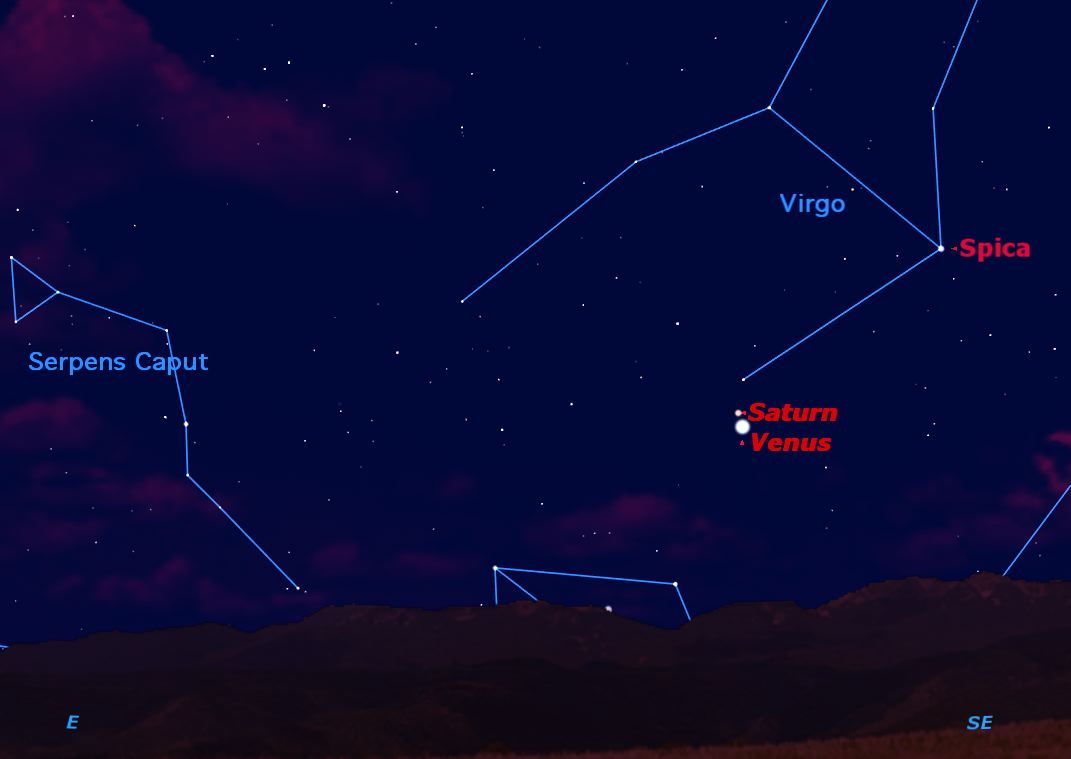
You’ve no doubt heard of the phrase, "like two ships that pass in the night." Well, come early Tuesday morning (Nov. 27), you’ll be able to watch two planets that will pass each other in the dawn.
The planets in question are Venus and Saturn. One planet will be slowly descending into eventual obscurity, while the other will become increasingly prominent in the days and weeks to come.
Look for Venus and Saturn shortly after 4:30 a.m. local time. The planets will appear very low above the east-southeast horizon, weather permitting. Brilliant Venus, shining with a steady silvery-white glow, will be passing about 0.6 degrees below and to the right of the much dimmer and yellower Saturn. (Your closed fist held at arm's length covers 10 degrees of the night sky.)
About an hour later, at 5:30 a.m. local time, Saturn will high enough for good views through a telescope of its breathtakingly beautiful rings. The tilt of the rings continues to slowly increase and is now almost 18 degrees from edgewise. As for Venus, it displays a rather small gibbous shaped disk, 87 percent illuminated by the sun. Venus is about 70 percent brighter than Saturn’s larger, but duller, disk and rings. [Dazzling Venus Views from Earth (Photos)]
After Tuesday morning's rendezvous, which is known as a conjunction, the two planets will slowly go their separate ways.
Venus, which was so prominent during the summertime, is now rising later and appearing lower to the horizon in the dawn twilight. It has about another two months to go before it ultimately drops down into the bright morning twilight and disappears from our view, eventually transitioning into the evening sky by early next spring.
Saturn, on the other hand, will climb progressively higher and rise earlier, eventually becoming a prominent and well-placed evening object by the middle of spring.
Get the world’s most fascinating discoveries delivered straight to your inbox.
If you look at both Venus and Saturn through a telescope, Venus is unquestionably the brighter of the two objects. But you might wonder how this is possible. After all, both planets are perpetually covered with clouds and their respective albedos — the proportion of the incident sunlight reflected by those clouds — are exactly the same at 76 percent.
Why then does Saturn appear so much duller than Venus if both are reflecting the same proportion of sunlight back toward the Earth?
The key is their distances from the sun. Compared to Venus, Saturn is 13.59 times farther away from the sun. And if we use the inverse square law — which states that the intensity of reflected sunlight is inversely proportional to the square of the distance from the sun — then 13.59 multiplied by 13.59 shows that sunlight striking Saturn’s cloud tops, is 184.69 times weaker compared to sunlight striking the cloud tops of Venus.
In any case, arise early on Tuesday and take a peek as the Venus, the Goddess of Beauty, snuggles up to Saturn, the God of Time.
Joe Rao serves as an instructor and guest lecturer at New York's Hayden Planetarium. He writes about astronomy for The New York Times and other publications, and is also an on-camera meteorologist for News 12 Westchester, New York. Follow SPACE.com on Twitter @Spacedotcom, Facebook & Google+.




